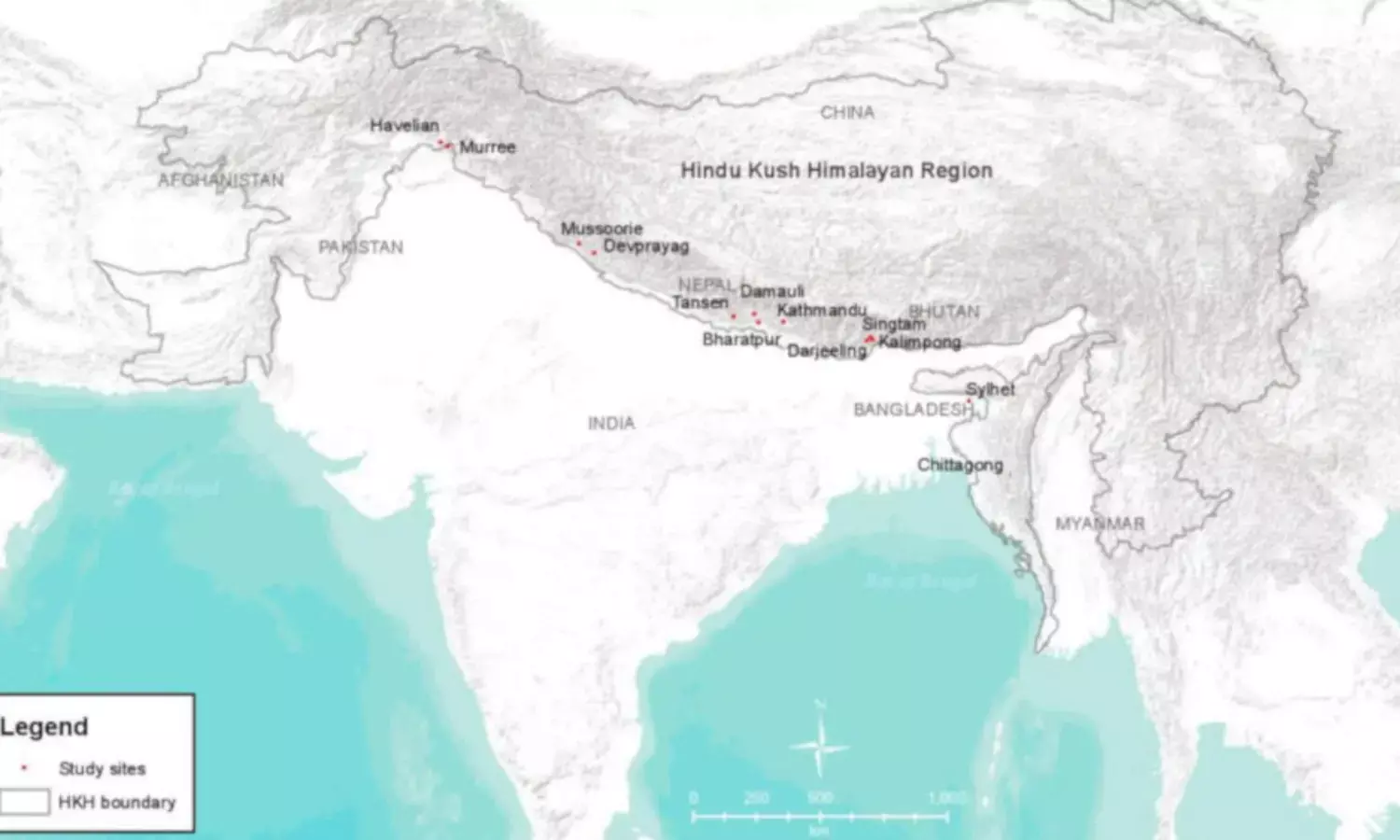வறட்சி நோக்கி நகரும் டார்ஜிலிங், முசோரி & காத்மாண்டு போன்ற இமயமலை நகரங்கள்

பெங்களூரு: முசோரி, டார்ஜிலிங், காத்மாண்டு போன்ற புகழ்பெற்ற மலைப்பகுதி நகரங்கள், விரைவில் கடும் தண்ணீர் பிரச்சனையை சந்திக்க நேரிடும்; தேவை மற்றும் விநியோக இடைவெளி ஏற்கனவே சில நகரங்களில் 70% அளவுக்கு அதிகமாக உள்ளது என்று புதிய ஆராய்ச்சி காட்டுகிறது.
இந்துகுஷ் இமயமலை (எச்.கே.எச்) பிராந்தியத்தில் அமைந்துள்ள இந்தியா, பாகிஸ்தான், நேபாளம் மற்றும் பங்களாதேஷ் ஆகிய்வற்றின் 13 நகரங்களில் நடந்த 10 ஆய்வுகள், தொடர்ச்சியாக நீர் மற்றும் காலநிலை மாற்ற முறிவுகளை கண்டறிந்து உள்ளன.
ஐதராபாத்தில் உள்ள இந்தியன் ஸ்கூல் ஆஃப் பிசினஸில் (ஐ.எஸ்.பி) பாரதி இன்ஸ்டிடியூட் ஆப் பப்ளிக் பாலிசி ஆராய்ச்சி இயக்குநரும், இணை இணை பேராசிரியருமான அஞ்சல் பிரகாஷ் கூறுகையில், “இமயமலைப்பகுதி நகர்ப்புறங்கள் வறட்சியை நோக்கி செல்கின்றன. அவற்றின் பெரும்பாலான நீர் ஆதாரங்கள், நிலத்தடியில் இருந்து கிடைப்பவை மற்றும் காலநிலை மற்றும் காலநிலை அல்லாத காரணிகளின் சிக்கலான கலவையால் அவை சரிந்து வருகின்றன" என்றார். ஆசியாவின் மிகப்பெரிய ஆறுகளில் பத்து, இந்து குஷ் மலைத்தொடர்களில் உருவாகின்றன; மேற்கில் ஆப்கானிஸ்தானில் இருந்து கிழக்கில் சீனா வரை பாய்கின்றன. ஆயினும்கூட, இங்குள்ள தேவைக்கும் நீர் வழங்கலுக்கும் இடையிலான இடைவெளி, வரும் 2050ம் ஆண்டுக்குள் இரட்டிப்பாகும் என்று ஆராய்ச்சி கண்டறிந்துள்ளது. கணக்கெடுக்கப்பட்ட எட்டு நகரங்களில் உள்ள இடைவெளி 20% -70% ஆகும், அவை, 50% முதல் 100% வரை நிலத்தடி நீரூற்றுகளையே அதிகம் சார்ந்துள்ளன.
மார்ச் 1, 2020 அன்று வெளியான சர்வதேச மதிப்பாய்வு இதழான வாட்டர் பாலிசி-இன் சிறப்பு இதழில், இரண்டு ஆண்டுகளாக செய்யப்பட்ட 10 ஆய்வுகள் தொடர்பான கட்டுரையானது இடம் பெற்றுள்ளது. பிரகாஷ், நேபாளத்தை சேர்ந்த ஒருங்கிணைந்த மலை மேம்பாட்டுக்கான சர்வதேச மையத்தின் (ஐ.சி.ஐ.எம்.ஓ.டி) இயக்குநர் ஜெனரல் டேவிட் ஜேம்ஸ் மோல்டனுடன் சேர்ந்து, அதை திருத்தி, ஆய்வுகளுடன் வந்த தலையங்கத்தில் முக்கிய பகுதிகளை சுருக்கமாகக் கூறியிருக்கிறார்.
விரைவான நகரமயமாக்கல் மற்றும் காலநிலை நெருக்கடி மீதுள்ள புகார்
தற்போது, மொத்த இந்துகுஷ் மலைப்பிராந்திய மக்கள்தொகையில் 3% பெரிய நகரங்களிலும், 8% சிறிய நகரங்களிலும் வாழ்வதாக தலையங்கம் கூறுகிறது. 2050ம் ஆண்டு வாக்கில், பிராந்தியத்தில் 50% க்கும் அதிகமான மக்கள் நகரங்களில் வசிப்பார்கள். கணிப்புகளின்படி, இது நீர்வளங்களின் நெருக்கடியை மேலும் அதிகரிக்கும்.
விரைவான நகரமயமாக்கல் பற்றி அதே கருத்தை முன்வைக்கும் ஆய்வுகளில் ஒன்று, மோசமான நீர் நிர்வாகம், திட்டமிடல் இல்லாதது, சீசன் காலத்தில் மோசமான சுற்றுலா மேலாண்மை மற்றும் காலநிலை முறிவு போன்றவை நீர் நெருக்கடிக்கு காரணம் என்று குற்றம் சாட்டுகிறது.
இந்திய இமயமலை நகரங்களான முசோரி மற்றும் தேவ்ப்ரயாக் ஆகியன தொடர்பான மற்றொரு ஆய்வு, குறிப்பிடத்தக்க சுற்றுலா இருந்தபோதிலும், மழைநீர் சேகரிப்பு, புயல் மழை மேலாண்மை மற்றும் சரியான கழிவுநீர் அமைப்புகள் இல்லை என்பதை எடுத்துக்காட்டுகிறது.
நீர்த்தேவை அதிகரித்துள்ள நிலையில், மழையின் வடிவங்களின் மாற்றத்தாலும், நிலத்தடி நீர் கிடைப்பது தடைபட்டுள்ளதாலும், தண்ணீர் வினியோகம் பாதிக்கப்பட்டுள்ளது. "மலைகளில் காலநிலை மாற்றம் என்பது பற்றி நாம் நினைக்கும் போது, பனிப்பாறைகள் உருகுவதை தான் நாம் நினைக்கிறோம்," மோல்டன் கூறினார். "இது ஒரு முக்கியமான பிரச்சினை தான். ஆனால், மழை வடிவ மாற்றம், நிலத்தடி நீர் இழப்பு போன்றவை நாம் நாம் கவனிக்கத்தவறும் பிரச்சினை" என்றார் அவர்.
வரவிருக்கும் ஆண்டுகளில், வெள்ளத்தை போலவே அதீத மழைப்பொழிவு அதிகரிக்கும் என்று கணிக்கப்பட்டுள்ளது என்று, காலநிலை மாற்றம் குறித்த விஞ்ஞானத்தை மதிப்பிடுவதற்காக அமைக்கப்பட்ட ஐ.நா. அமைப்பு, காலநிலை மாற்றத்திற்கான இடைக்கால குழுவின் (ஐபிசிசி) சமீபத்திய அறிக்கைகள் தெரிவிக்கின்றன. சில இடங்கள் ஈரப்பதம் கொண்டதாக மாறும் என்று எதிர்பார்க்கப்பட்டாலும், மற்றவை வறண்டுவிடும்; இந்தியா ஸ்பெண்ட் முன்பு தெரிவித்தபடி, ஒழுங்கற்ற பருவமழை ஏற்கனவே பயிர்களை சேதப்படுத்துகிறது; இது, இந்தியாவில் பசியுள்ள வறியவரியளின் எண்ணிக்கையை அதிகரிக்கக்கூடும்.
“காலநிலை மற்றும் தண்ணீரின் கதை எளிதானது” என்று பெங்களூரு இந்திய மனித குடியேற்றக் கழகத்தின் (IIHS) மூத்த காலநிலை மாற்ற ஆராய்ச்சியாளர் அமீர் பஸாஸ் விளக்கினார். “கட்டுரை, மழைப்பொழிவுடன் தொடர்புடையது. காலநிலை மாற்றம் மழைப்பொழிவு முறைகளை மாற்றிவிடும், வேறு எந்த ஆதாரமும் இல்லாததால் அனைத்து நீர்நிலைகளும் மழைப்பொழிவில் இருந்து தான் தண்ணீரைப் பெறுகின்றன” என்றார்.
அந்தந்த பகுதி நீர்நிலை நீரூற்றாக, மலைகள் உள்ளன - மக்கள்தொகை அதிகரிப்பதன் மூலமும், அதீத மற்றும் மழை வடிவங்களை மாற்றத்தால், அவற்றின் நிலத்தடி நீர் போதுமான அளவு செறிவூட்டப்படவில்லை.
இதில் தீர்வைத் தேடுவதை சிக்கலாக்குவது என்னவென்றால், நிலத்தடி நீர் உள்ள பகுதி இன்னும் கண்டறியப்படவில்லை; அவற்றின் பருவநிலை புரியவில்லை என்று பிரகாஷ் கூறினார். "ஐபிசிசி அறிக்கைகள் கணித்துள்ள காலநிலை அபாயங்களை எதிர்கொள்ள நகரங்கள் [மலைகளில்] தயாராக இல்லை," என்று அவர் கூறினார்.
இந்தியாவின் இமயமலை செல்லும் 12 மாநிலங்களில் அஸ்ஸாம், மிசோரம், ஜம்மு காஷ்மீர் மற்றும் லடாக் ஆகிய யூனியன் பிரதேசங்கள் காலநிலை மாற்றத்திற்கு மிகவும் பாதிக்கப்படுகின்றன என்று இந்தியா ஸ்பெண்ட் கட்டுரை முன்பு அறிவித்தது.
மோசமாக பாதிக்கப்பட்டவர்கள்: புலம்பெயர்ந்தோர், ஏழைகள் மற்றும் பெண்கள்
ஆய்வு செய்யப்பட்ட நாடுகளில் நீர் நெருக்கடி அனுபவங்களை ஆய்வு செய்ததில், பல ஆண்டுகளாக வர்க்கம், சாதி மற்றும் பாலின அடிப்படையில் வேறுபடுகின்றன. காத்மாண்டுவில் உள்ள பணக்கார குடும்பங்கள் ஏழை வீடுகளை விட 38.2% குறைவாக தண்ணீருக்காக செலவிடுகின்றன என்பதை இந்த தொடரின் ஆய்வில் ஒன்று கண்டறிந்துள்ளது. காத்மாண்டுவின் ஏழை வீடுகளில் கிட்டத்தட்ட 20% குடிமை அமைப்புகளால் நிர்வகிக்கப்படும் முறையான நீர் விநியோகத்தை அணுக முடிவதில்லை. இந்த வீடுகள் தனியார் தண்ணீர் சப்ளையர் போன்ற விலையுயர்ந்த முறைசாராத தண்ணீர் வழங்கும் அமைப்புகளை சார்ந்துள்ளன.
தண்ணீர் பொருளாதாரம் என்பது முறைசாராத அமைப்பில் இருந்து முறைசார்ந்த நிலைக்கு மாறினால் ஏழைகள் ஆதாயமடைகிறார்கள். "மக்களுக்கான நீர் பெறும் உரிமையில் பெரும் ஏற்றத்தாழ்வுகள் மற்றும் வேறுபாடுகள் உள்ளன" என்று பிரகாஷ் கூறினார். வீடுகளுக்குள், பெரும்பாலான சந்தர்ப்பங்களில், தண்ணீரை நிரப்புவதற்கான சுமை பெண்கள் மீது விழுகிறது என்பதை, ஒடிசா மற்றும் ராஜஸ்தான் பகுதிகளில் இருந்து இந்தியா ஸ்பெண்ட் அளித்த களநிலவர கட்டுரை தெரிவித்தது. இதேபோன்ற போக்கு நேபாளத்தின் மலைப்பகுதிகளிலும் கண்டறியப்பட்டு பதிவு செய்யப்பட்டுள்ளது.
கிராமப்புறங்களில் இருந்து நகர்ப்புறத்திற்கு குடியேறுபவர்கள், இதில் பாதிக்கக்கூடிய மற்றொரு தரப்பினர் ஆவர். 2018ம் ஆண்டில் 148 நாடுகள் மற்றும் பிராந்திகளில் மோதல்கள் மற்றும் பேரழிவுகள், 28 மில்லியன் புதிய இடப்பெயர்வுகள் வழிவகுத்ததாக, 2019 மே மாதம் வெளியிடப்பட்ட உள்நாட்டு இடப்பெயர்வு குறித்த உலகளாவிய அறிக்கையில் தெரிவிக்கப்பட்டுள்ளது.
இந்தியாவில் இதுவரை, காலநிலை மாற்றத்தால் இடம் பெயர்ந்தவர்களை கணக்கிட எந்த முறையும் இல்லை; ஆனால் காலநிலை மாற்றத்தின் தாக்கங்களால் மிகவும் பாதிக்கப்படக்கூடிய, ஆய்வுக்குட்பட்ட 181 நாடுகளில் நாடுகளில் ஐந்தாவது இடத்தில் உள்ளது என்று, இந்தியா ஸ்பெண்ட் 2019 டிசம்பர் கட்டுரை தெரிவித்தது.
“நகரத்திற்கு வரும் புலம்பெயர்ந்தோர், பின்தங்கிய நிலையில் உள்ளனர். பெண்களும் பின்தங்கிய நிலையில்தான் உள்ளனர். ஏழைகள் பெரும்பாலும் பின்தங்கியே காணப்படுகின்றனர், ”என்று ஐசிஐஎம்ஓடி- யின் மோல்டன் கூறினார். "இதில் உண்மையில் நெருக்கடி நிலவுகிறது" என்றார்.
சிறந்த நீர் நிர்வாகத்தின் தேவை
சாத்தியமான தீர்வுகளை முன்னிலைப்படுத்த, இத்தொடர் உதாரணத்திற்காக, மேற்கு வங்கத்தின் உள்ள டார்ஜிலிங்கை - நீர் நிறைந்த பிராந்தியத்தில் அமைந்துள்ள ஒரு நகரம் - காட்டுகிறது. டார்ஜிலிங்கின் முக்கிய பிரச்சனைகளில் ஒன்று, உள்ளூர் நகராட்சி அமைப்பால் தண்ணீரை தவறாக நிர்வகிப்பதும்; பழைய ஆங்கிலேயர் கால தண்ணீர் வினியோக கட்டமைப்புகளை மாற்றியமைப்பதில் போதிய முதலீடுகளும் இல்லாததும் தான் என்று ஆய்வு தெரிவிக்கிறது.
நீர் நெருக்கடிகளுக்கு சரியான பதில், திறமையான உள்ளாட்சி அமைப்புகள் மற்றும் உள்ளூர் தீர்வுகள் தான் என்று ஆய்வு தெரிவிக்கிறது. நீர் நிர்வாகத்தில் பெண்களின் பங்கிற்கு கூடுதல் ஊக்கம் தேவை; அது, அவை திட்டமிடல் மற்றும் முடிவெடுக்கும் செயல்முறைகளின் ஒரு பகுதியாக இருக்க முடியும். "நமக்கு தீர்வுகள் தேவை, முதலீடுகள் தேவை. ஆனால் அவை மலை சார்ந்த பகுதிகளுக்கு உகந்ததாக இருக்க வேண்டும்; அவை ஏற்கனவே உள்ள வளங்களை கவனத்தில் கொள்ள வேண்டும்" என்று மோல்டன் கூறினார்.
(ஷெட்டி, இந்தியா ஸ்பெண்ட் செய்திப்பணியாளர்).
உங்களின் கருத்துகளை வரவேற்கிறோம். கருத்துகளை respond@indiaspend.org. என்ற முகவரிக்கு அனுப்பலாம். மொழி, இலக்கணம் கருதி அவற்றை திருத்தும் உரிமை எங்களுக்கு உண்டு.

